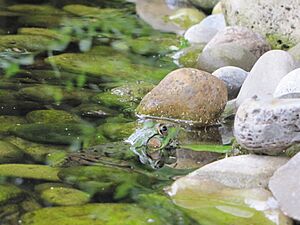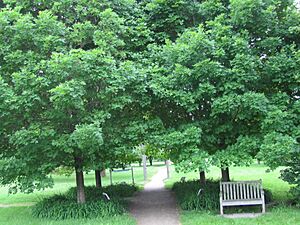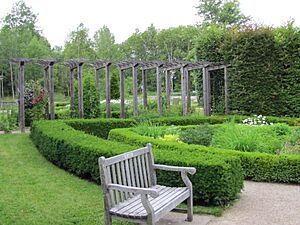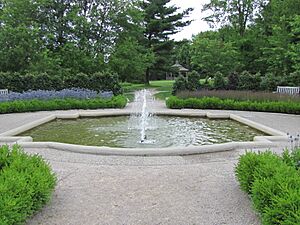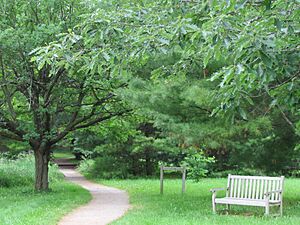University of Guelph Arboretum facts for kids
Quick facts for kids University of Guelph Arboretum |
|
|---|---|

A summer day in The Arboretum.
|
|
| Facts | |
| Location: | Guelph, Ontario |
| Coordinate | 43°32′27″N 80°12′54″W / 43.54083°N 80.21500°W |
| Built: | 1971 |
| Area: | 165 hectares (410 acres) |
| Director: | Justine Richardson |
| Governing Body: | University of Guelph |
| Homepage: | University of Guelph Arboretum |
The Guelph Arboretum is a special place at the University of Guelph in Ontario, Canada. It's like a big outdoor museum for trees and plants. It was started in the early 1970s. Since then, it has grown into many different gardens and plant collections.
The Arboretum is open to everyone, all year round, from when the sun comes up until it sets. About 73,500 people visit each year! It's used for teaching, research, and many fun events. You can find university classes, school programs, and workshops for adults here. It's also a popular spot for weddings or special memorial services.
As of 2020, Justine Richardson is the Director. Over 100 volunteers from the University of Guelph and the local community help keep the Arboretum beautiful. They do things like gardening, helping with events, and supporting the staff.
Contents
Exploring the Arboretum's Area
The Guelph Arboretum is located in Guelph, Ontario. It covers 165 hectares, which is about 408 acres. That's a lot of space to explore! It has 8.2 kilometers (about 5 miles) of trails. Some popular trails are the Ivey Trail and the Trillium Trail.
This amazing place is home to many different animals. You might see 38 types of mammals, 188 kinds of birds, and 39 species of butterflies. There are also 18 types of reptiles and amphibians. In winter, you might spot opossums, coyotes, foxes, or cottontail rabbits.
Weather at the Arboretum
The weather at the Guelph Arboretum changes throughout the year. The average temperature is about 6.5 degrees Celsius (43.7 degrees Fahrenheit). July is the warmest month, averaging 19.7 degrees Celsius (67.5 degrees Fahrenheit). January is the coldest, with an average of -7.6 degrees Celsius (18.3 degrees Fahrenheit).
The Arboretum gets about 771.4 mm (30.4 inches) of rain each year. It also gets about 160.8 cm (63.3 inches) of snow. This climate helps many different plants grow here.
Amazing Plant Collections
The Arboretum is home to 1,700 different types of trees and shrubs. Most of these plants are native to Southern Ontario. The Arboretum focuses a lot on woody plants, which are plants with hard stems like trees and shrubs.
There are over 40 different plant collections here. These collections include both native plants and plants brought from other places. These collections are used for research and to teach people about plants. They also help restore habitats and protect rare plants. Each plant has a detailed label with its common name, scientific name, and where it naturally grows.
Special Plant Gardens
The Arboretum has several special gardens. These include collections of Maple trees, crab apples, birch trees, and conifers. These collections show how diverse these plant families can be.
You can also find collections of Roses, lilacs, and dwarf conifers. The rose collection is special because it's grown without using many insecticides or fungicides. This helps visitors see which roses can grow well in a garden without chemicals.
Unique Features of the Arboretum
Frances Ball Rose Garden
The Frances Ball Rose Garden has over 115 different kinds of roses. Since the Arboretum tries to use very few pesticides, they chose roses that don't need much spraying. The roses usually bloom from June to July, with some blooming into early August.
Leslie Hancock Memorial Rhododendron Collection
This collection features over 65 types of Rhododendrons. Most rhododendrons are shrubs. This collection is named after Leslie Hancock, who helped grow and promote these plants in Ontario. The plants here are chosen because they can grow well in the Southern Ontario climate, as long as they are protected from strong sun and wind.
The World of Trees and Dwarf Conifer Collection
The World of Trees has over 400 types of woody plants from 67 different plant families. You can follow a 0.9 km (about half a mile) trail to see them all. Each plant has a black metal label at its base. This collection includes Maples, Beech trees, Willows, and Pines.
The Dwarf Conifer Collection shows over 150 different dwarf conifers. These plants are not trimmed or shaped, so you can see them in their natural form. Even "dwarf" conifers can grow quite large! They look their brightest in June and September.
Gosling Wildlife Gardens and The Wall Custance Memorial Forest
The Gosling Wildlife Gardens are designed to inspire visitors to create wildlife-friendly gardens at home. These gardens show plants that attract wildlife like butterflies, moths, and hummingbirds. They also teach about how people and wildlife can live together. There are five different garden styles, like a butterfly garden and a native plants garden.
The Wall Custance Memorial Forest is a special program where people can have a tree planted to remember a loved one. Over 8,500 trees and shrubs have been planted here in the past 22 years. There's a 1.4 km (about 0.9 mile) trail through this forest.
G. Porter Memorial Japanese Garden
This peaceful garden was opened in 1995. It has a special gateway, a bamboo fence, and a stone bridge that crosses a reflecting pool. Beyond the bridge, you'll find a small teahouse. The garden is designed to help visitors feel calm and relaxed. It uses specific plants and features to create a traditional Japanese feel, which is great for city environments.
Edna and Frank C. Miller English Garden
This garden shows a traditional British style of gardening. It was dedicated in 1998. It features neatly trimmed beech and cedar hedges that create a balanced pattern. There are also pergolas (garden arches) that offer different views of the garden. You can see a silver maple and an English oak tree, chosen for their beautiful shapes. The garden also has a sundial.
When to Visit
The Arboretum has different hours for its buildings and its outdoor grounds. The Arboretum Centre building is open from 8:30 a.m. to 4:30 p.m., Monday to Friday. The outdoor grounds are open from dawn to dusk, every day of the year.
What the Arboretum Offers
The Guelph Arboretum offers many programs and workshops all year round. It's a popular place for people from Guelph and all over Ontario to visit. Whether you want to enjoy the scenery, study, or hold an event, the Arboretum has something for you.
When you arrive, you can pick up brochures at the entrance for self-guided tours. It's free to enter the Arboretum grounds!
Guided Walks and Tours
The Arboretum offers 1.5-hour group walks led by friendly guides. You need to sign up for these walks. In the summer, walks are offered every Wednesday from June 1 to August 3, starting at 7 p.m. You can also get special tours led by Arboretum staff. These tours can focus on different topics like plants, wildlife, or history.
Trails to Explore
Ivey Trail The Ivey Trail is 1.1 km (about 0.7 miles) long. You can find it by looking for white "IVEY" signs on the trail posts. This trail starts at the Arboretum entrance and leads to the J.C. Taylor Nature Centre. It's a central trail that connects to most of the Arboretum's other paths.
Trillium Trail This is a 2.0 km (about 1.2 miles) loop trail. It goes through 10 different plant collections and crosses many other Arboretum trails. On the Trillium Trail, you'll see over 30 types of native and exotic trees. This trail is even open in winter for cross-country skiing!
Fun Workshops
The Arboretum offers many different workshops throughout the year. You can learn about owls, mushrooms, or shrubs. There are also workshops on sketching nature, taking photos of wildflowers, and designing gardens. Check their website to see what's currently being offered!
Places to Rent
You can rent spaces at the Arboretum for many different events. These include weddings, meetings, conferences, and parties. They have an Auditorium, a Boardroom, a Sunroom, and an outdoor space for ceremonies. All rental areas offer catering, are smoke-free, are wheelchair accessible, and have free parking.
Painting on the Green
"Painting on the Green" is an outdoor art show held every June since 1960. It used to be called the Outdoor Art Exhibition. For the past three years, it has been held at the University of Guelph Arboretum. Over 40 artists display their paintings, photos, and other artworks at this event.
Protecting Plants: The Gene Bank
In 1979, the Arboretum started a "gene bank" to protect rare woody plants in Ontario. This means they save genetic information from these plants. Right now, they have genetic information from over 20 rare species. For example, they help preserve the endangered Canadian Cucumber Tree. The goal is to keep these rare plants safe and to let landowners know about them.
Working with Others
The Guelph Arboretum is part of several important groups. These include the American Association of Botanical Gardens and Arboreta and Botanic Gardens Conservation International. They also exchange seeds with organizations around the world. They use wild seeds collected responsibly, extra seeds from the Arboretum, and seeds collected by volunteers. These partnerships help the Guelph Arboretum work towards plant conservation and research.


